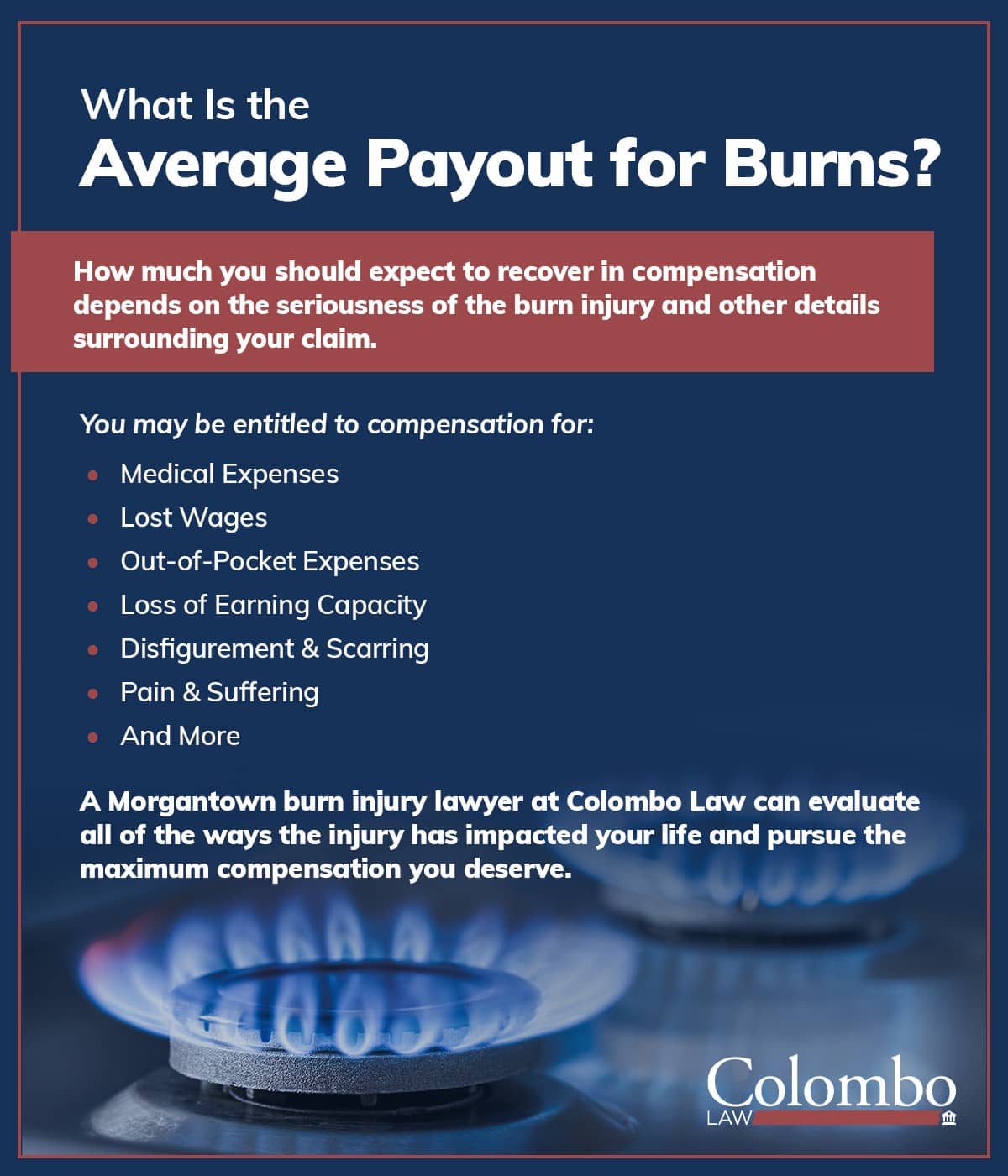Dedicated West Virginia Burn Injury Attorneys
The American Burn Association reports that 450,000 people are burned and have to visit the emergency room every year in the U.S. Of the burns seen yearly, roughly 3,400 are fatal. If you or a loved one have been burned, there is a possibility that you may be able to seek compensation for your injuries. Determining whether you have a case can be difficult, so it’s best to contact our Morgantown burn injury lawyers to find out if you have a right to take legal action.

National Burn Injury Statistics
Burns are far more common than many realize, resulting in hundreds of thousands of injuries and tens of thousands of hospitalizations in the United States each year. According to research by the American Burn Association:
- Nearly 400,000 burn injuries require medical treatment each year.
- Over 29,000 hospitalizations occur each year due to burns.
- In 2021 (the most recent year of data), 3,800 deaths occurred due to fire/smoke inhalation (3,010 due to structure fires and 680 due to automobile fires).
- Just 1,290 burns were severe enough to require surgery and prolonged ventilation, though the mortality rate was very high for these serious burns at 17.8%.
- Overall, the survival rate for burn injuries is 97.7%.
- Two-thirds of burn victims are male.
Sadly, many burn victims are children. According to the CDC, fires or burns result in nearly 300 deaths of children or adolescents and emergency medical attention or hospitalization for over 100,000 children annually.
According to Stanford Medicine, most scalding burns suffered by children—nearly 75%—are preventable.
How Do Burn Injuries Happen?
According to the Centers for Disease Control (CDC), 44 percent of burns are caused by direct contact with fire. On average, someone is injured by a burn every 30 minutes in the U.S.
Fire-related burns are also the third most common cause of deaths that occur in the home. Someone dies in a home fire, on average, every 2.5 hours in the U.S.
Additional causes of burn injuries include:
- Being scalded by steam or a hot liquid (33 percent)
- Coming into direct contact with another type of heat source (9 percent)
- Receiving an electrical burn (4 percent)
- Being burned by chemicals (3 percent)
- Being burned by other causes (7 percent)
As Morgantown burn injury lawyers, we’ve also seen victims who have been burned by:
- Car accidents
- Truck accidents
- Motorcycle accidents
- Defective products
- Natural gas accidents
- Explosions

Types of Burns and How They Should Be Treated
How severe someone’s burn injury is depends on how long they were exposed to the chemical or heat source and what the temperature of the heat source was. Burns can damage internal organs, but they are classified based on the damage they do to the skin. Burns may be classified as full-thickness or partial thickness, but are more commonly divided into degrees.
First-Degree Burns
First-degree burns (partial thickness) may result in red, non-blistered skin and/or slight swelling. These types of burns usually heal quickly (within a few days) if they don’t become infected. They should be treated by running the burn site under cool (not cold) water and applying an antibacterial burn cream. If the pain, redness, or swelling hasn’t gone down in 3-4 days, it’s best to see a doctor for further treatment.
Second-Degree Burns
Second-degree burns (partial thickness) occur when the damage extends beyond the first layer of skin. These types of burns can cause blisters and make the skin look as though it’s wet. Mild second-degree burns may be treatable if they are run under cool water, coated in burn ointment, and wrapped in a loose dressing. Severe second-degree burns that do not go away in 2-3 weeks or hurt for a week or more should be treated by a medical professional.
Third-Degree Burns
Third-degree burns (full thickness) happen when all the layers of the skin, and sometimes internal organs, are damaged. These types of burns can cause nerve damage so severe that the victim is no longer able to feel pain. They may make the skin look thick, black, leathery, or bumpy and should never be treated at home. If you or someone you know sustains a third-degree burn, do not rinse it or attempt to treat it in any way. Elevate the burned area, remove any clothing or item that is touching the burn, and go to the emergency room immediately.
Burn Injury Complications
Scarring and disfigurement after a burn can last a lifetime. If burns aren’t treated appropriately, they can result in blood loss, infections, tetanus, shock, and even death. Electrical burns and chemical burns are especially dangerous, as they can damage internal organs without showing external damage.
Burns to the feet, hands, face, or groin are much more dangerous and should be treated by a doctor or in the emergency room as soon as possible.
Severe burns may require the victim to undergo surgery or skin grafting which are both painful and expensive. Victims may also suffer emotional damage that can require therapy to overcome.

Hiring a Morgantown Burn Injury Lawyer
Your right to seek compensation for your burn injury depends on the circumstances.
For instance, if you were burned in a place of business, like a school, retail establishment, or restaurant, you may be able to get money for your injuries. In this scenario, you could be able to file a suit against the owner or company who contributed to your burn accident.
If your burn was the result of a defective product, you could have the opportunity to sue the product’s manufacturer or retailer. If you were burned while working, you could potentially file a claim against your employer.
At Colombo Law, we employ an in-house medical professional to help us determine whether your burns are severe enough to seek compensation. After you’ve been treated by your doctor, you should schedule a free consultation with us so we can discuss your future treatment needs and develop a life care plan that shows how much money this experience will cost you.
Get in touch Colombo Law in Morgantown by calling 304-599-4229 to find out if you have a burn injury case.
Frequently Asked Questions About Burn Injuries
What Is the Average Payout for Burns?
As with any type of injury, how much you should expect to recover in compensation depends a great deal on the seriousness of your injuries and other details surrounding your claim. Because of this, averages are not very helpful.
That said, payouts for burn injuries can be very high due to the long-lasting, sometimes permanent consequences of burn injuries. For example, Colombo Law was able to settle a burn injury case for a client for $3 million due to the fact that he sustained permanent injuries and other significant damages. We recovered $8 million for another burn victim and $21,500,000 for another.
These should just be treated as examples and do not reflect how much you should expect if you are pursuing compensation for a burn injury. However, learning about others’ experiences can be helpful when evaluating your own situation.
How Much Compensation for 2nd Degree Burns?
Burns are evaluated according to two factors. The first is the depth of the burn—that is, how far into the skin it goes. This is categorized by what we commonly hear as first-, second-, and third-degree burns.
Second-degree burns are moderately severe from a depth perspective. In some cases, they can be treated at home.
However, the second factor to consider is how much of a burn victim’s body is affected by the burn. This is expressed as a percentage of their total body surface area (TBSA). There are some thresholds that determine how serious a burn is based on TBSA:
- 15%: According to the National Institutes of Health, any burn with a 15% TBSA or above is considered a “major burn.”
- 25%: When the TBSA reaches 25%, a systemic inflammatory response happens.
- >50%: At 50% and above, a burn is considered a “massive burn injury” and leads to a significant mortality risk.
These factors are why compensation can vary so greatly in burn injury claims, even when discussing the same degree of burns.
How Much Compensation for 3rd Degree Burns?
Third-degree burn claims are more likely to result in significant compensation than less serious burns. This is due to the high cost of medical treatment for emergency care, surgery, skin grafts, and hospitalization.
Medical care for a third-degree burn can easily result in tens or hundreds of thousands of dollars in expenses. Additional losses you may be entitled to include:
- Lost wages
- Loss of earning capacity
- Emotional and psychological ramifications of third-degree burns, including disfigurement and scarring
- Out-of-pocket expenses, including those related to lifestyle modifications
- And more
Calculating how much you should pursue in compensation should be based on these damages, not necessarily the degree of the burn. An experienced burn injury lawyer can help.
Can I Pursue a Claim for a Burn?
In many cases, yes, you can pursue compensation for a burn injury by pursuing legal action. How you go about pursuing a claim depends on who was responsible for the burn injury, along with where and how it happened. For example:
- If the burn injury happened on the job, such as a natural gas site explosion, you may have both a workers’ compensation claim and a third-party personal injury claim.
- If you suffered a burn injury in a car accident due to the negligence of another driver, you would usually file a claim with the driver’s insurance company to recover compensation.
- If the accident was caused by a truck driver, you may file a claim or lawsuit against both the driver and the trucking company if negligence was the cause of the accident.
Ultimately, how you pursue a claim and who you pursue it against will depend on a variety of factors. An experienced burn injury attorney will be able to take a close look at your situation and perform a complete and thorough investigation to determine the best path forward for filing a claim and recovering the maximum compensation you deserve for your damages.
What Are General Damages for Burns?
Compensable losses for burn injuries may include both economic damages and non-economic damages. Non-economic losses are also known as general damages.
General damages in a burn injury claim may include:
- Pain and suffering
- Emotional anguish and distress
- Permanent disability
- Scarring and disfigurement
- Loss of enjoyment of life
Calculating how much compensation you deserve for each of these damages is best performed by a West Virginia burn injury attorney who understands how compensation is calculated and awarded to burn victims.
Is a Burn a Serious Injury?
The seriousness of burn injuries varies greatly, from minor problems to life-threatening emergencies. Serious complications may arise as a result of a burn injury, including:
- Bacterial infections
- Fluid loss
- Hypothermia
- Breathing problems
- And more
Beyond the physical effects, what can be especially challenging with burn injuries are the long-term effects they can have on a person’s appearance. Burns can result in disfigurement and scarring that can cause burn victims to withdraw from the world due to shame and embarrassment.
These psychological injuries can persist long after a person’s physical injuries have healed. Fortunately, there may be plastic surgery options for recovering one’s appearance; unfortunately, these procedures can be very expensive and require multiple surgeries over time.
A Morgantown burn injury lawyer can evaluate all of the ways the injury has impacted your life to date, as well as any future challenges you are likely to face. Colombo Law is committed to pursuing the maximum compensation you deserve.










